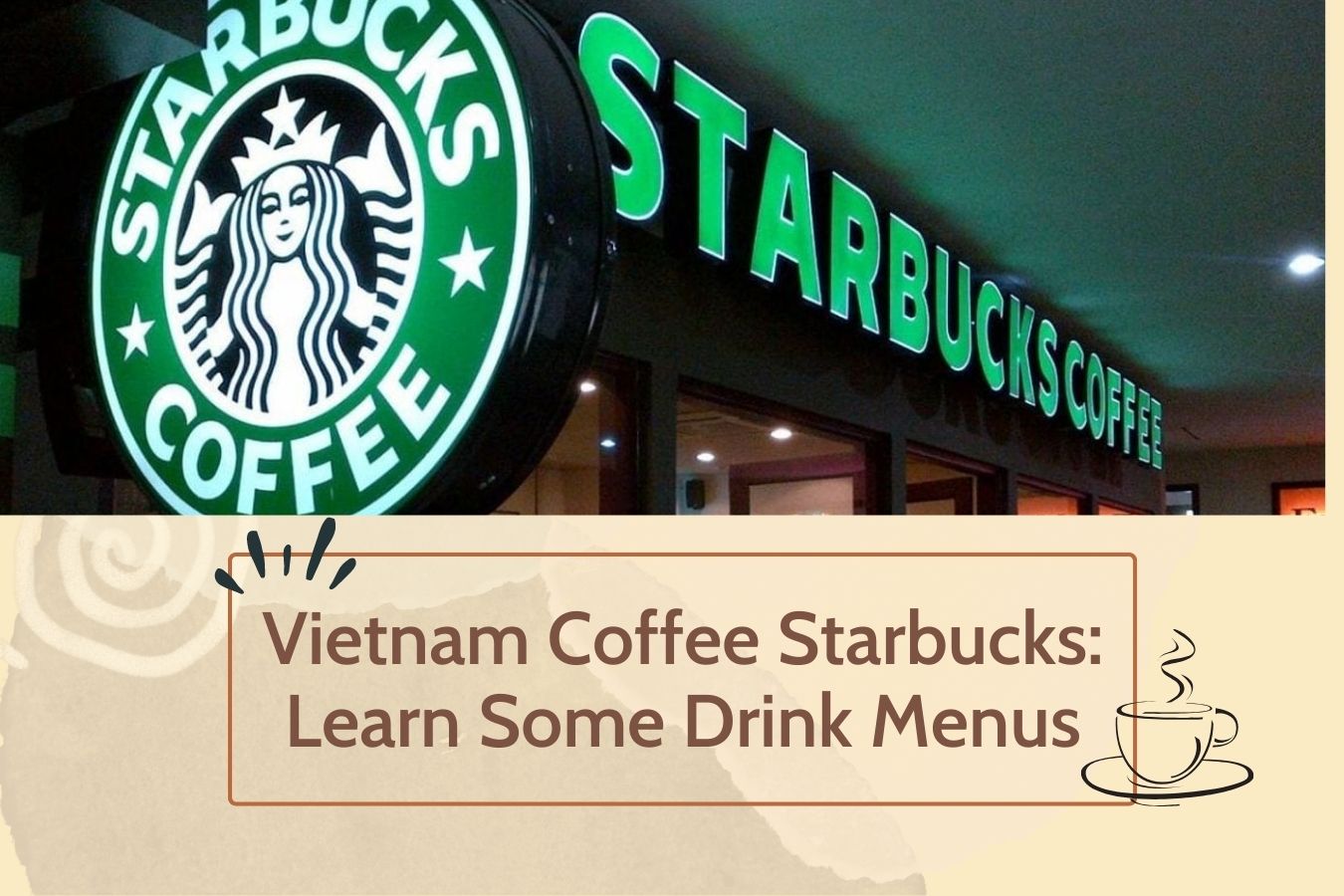
Vietnam Coffee Starbucks: Learn Some Drink Menus: Starbucks is the world’s leading coffee brand, owning more than 21,000 stores around 65 countries, of course, including Starbucks Vietnam. With the mission of being one of the fastest-growing branding companies in the US, Starbucks has contributed significantly to the economic development of the region each year.
Starbucks’ sales are still largely from crushed ice products (also known as frappuccinos) and off, ee accounts for a modest number in Vietnam. Of course, Starbucks coffee isn’t cheap, but a frappuccino is more expensive than a Starbucks coffee, but it’s novel. For many people, when it comes to coffee, they still have many options.
About Vietnam Starbucks coffee
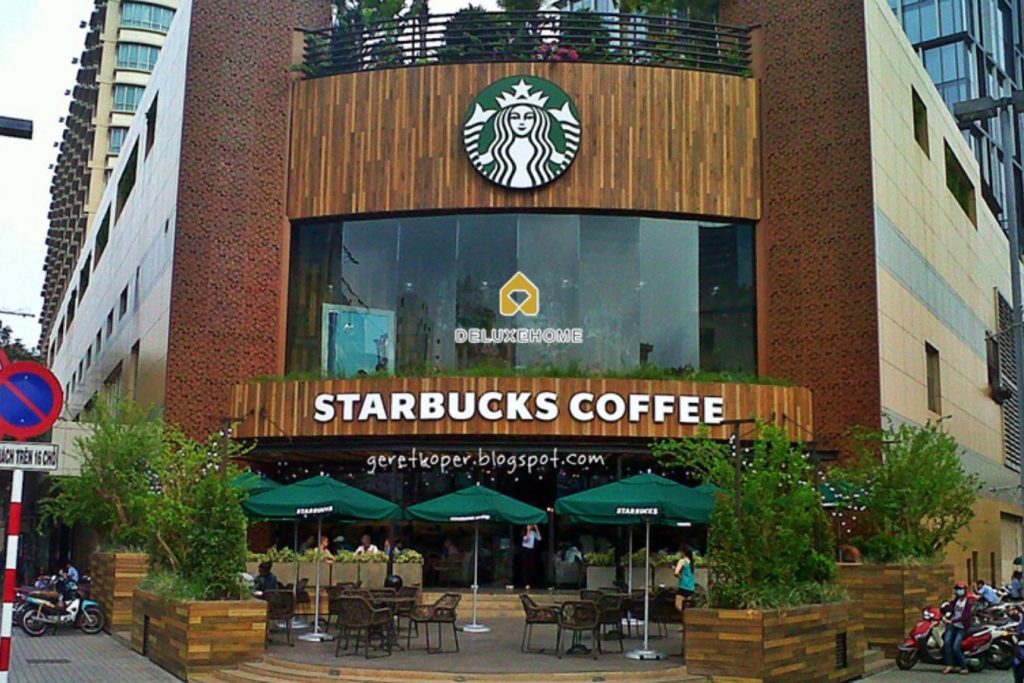
Starbucks is a famous coffee brand in the world today. Starbucks coffee company was established on March 30, 1971, at 2000 Western Avenue (Washington). The first three founders of Starbucks coffee were Jerry Baldwin – an English teacher, Zev Siegl – a history teacher, and Gordon Bowker – a writer.
Starbucks is headquartered in Seattle, Washington, USA. Currently, the company is present in 49 countries with 17,800 stores.
Starbucks entered Vietnam in 2013, with the first store in Ho Chi Minh City. Having just entered the Vietnamese market, the company has caused a fever when bringing a new and American-style coffee flavor.
So why are people reading about the Starbucks menu so much?
The main reason is unclear information. Espresso-based drinks are only available in barista manuals. In my personal opinion, those who do not know deeply about coffee, only know about espresso or cappuccino when entering shops that serve espresso field coffee (drinks made from espresso), including Starbucks. Once, I was quite surprised when a friend ordered a cappuccino because I thought it had the most espresso shots instead of ristretto Bianco(now changed to ‘flat white’). There are also new barista students, wondering about the difference between the amount of hot milk and foam milk between cappuccino and latte. Because of these things, plus the information about drinks that are disseminated quite ‘ambiguous’ to outsiders, I think it is necessary to have an article explaining most understandably.
So how to make it easy to understand the Starbucks menu as well as the menus of other coffee shops?
If you have to explain it in words or write it down on paper, maybe you are like me 5 – 6 years ago, after reading it, you will find everything even more difficult to understand. That’s why I tried scouring the Internet and looking for doodle illustrations about coffee. Fortunately, Starbucks China, Taipei, Philippines have just posted a series of illustrations of their drinks in a very clear, easy-to-understand way so that anyone can imagine how the drink is made. Without a moment’s hesitation, I immediately thought of including typical drawings in a new article, to help people grasp easier, faster, and understand what they are drinking every day. Here, I will take a look at a few drinks that many people are often confused about, even though they still ‘order’ every day.
Suggest some drinks at Starbucks Coffee Vietnam
Cappuccino and Latte

As you can see in the image above, the cappuccino and latte both have a shot of espresso as the core ingredient, along with steamed milk and foam milk. The difference is that with a latte, the amount of milk will be more and the top is a much thinner layer of fine foam than a cappuccino. This also makes a cappuccino have a thicker ‘body’ than a latte, and if you want to drink this type of coffee without having a strong coffee taste, or don’t like the strain of tilting the cup to see the coffee and milk flowing. Through the fine foam to drink, choose a latte. What about flat white? On the Starbucks menu, a flat white is somewhere in between cappuccino and latte. It has a slightly thinner layer of foam milk than a cappuccino, but steamed milk is still the same. The biggest difference is that the cappuccino only has 1 shot of espresso and the flat white is made with 2 shots. My comparison here is talking about the same thing The size of a Starbucks water glass, and of course, the larger size, the more milk, and espresso. So, if you want a cappuccino but more coffee, order flat white.
Nitro cold brew
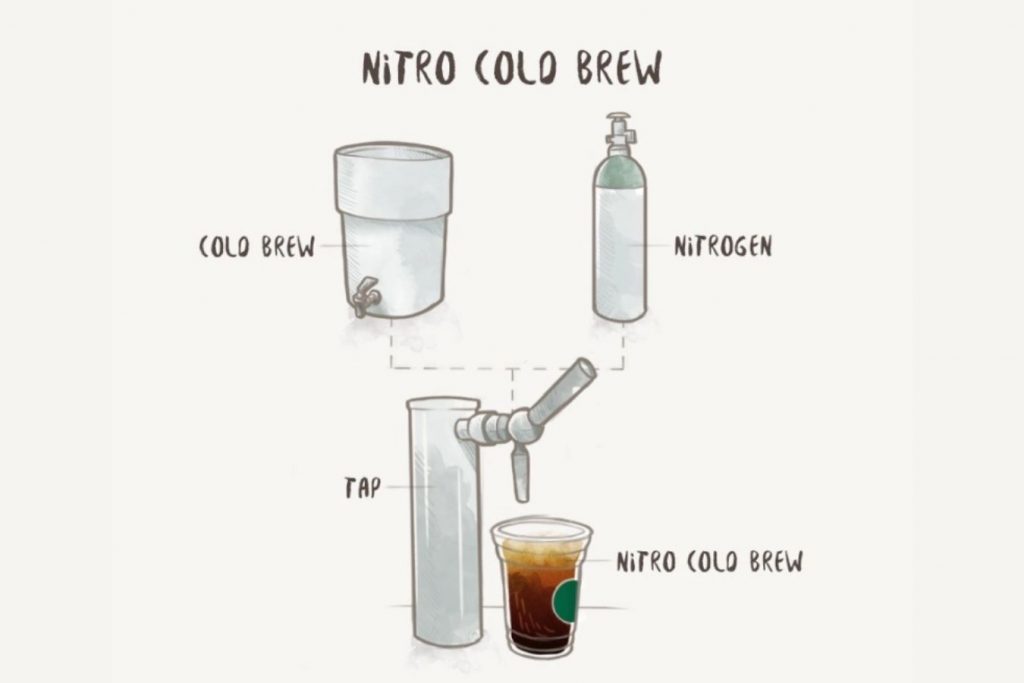
In Vietnam, you will only find the nitro cold brew at Starbucks Reserve stores. To make it easier to imagine, you can see this drink consists of 2 parts: The first part is cold brew, that is, coffee is brewed in cold water, in the refrigerator compartment with a time from 06 to 24 hours depending on the type. their coffee and cold brew equipment. In the next part, the coffee is taken out and passed through the nitrogen to create a creamy and cool. When drinking nitro cold brew, you will find the coffee taste quite light and cool and the crema layer is very fragrant and thick. It feels like drinking dark beer. If you’re thirsty and want a big, cool cup of coffee without too much coffee flavor in it, choose nitro cold brew. The point worth noting with this drink is that the price is quite expensive, as far as I remember, it is about 100K VND for a 300ml glass.
Americano and Brewed coffee
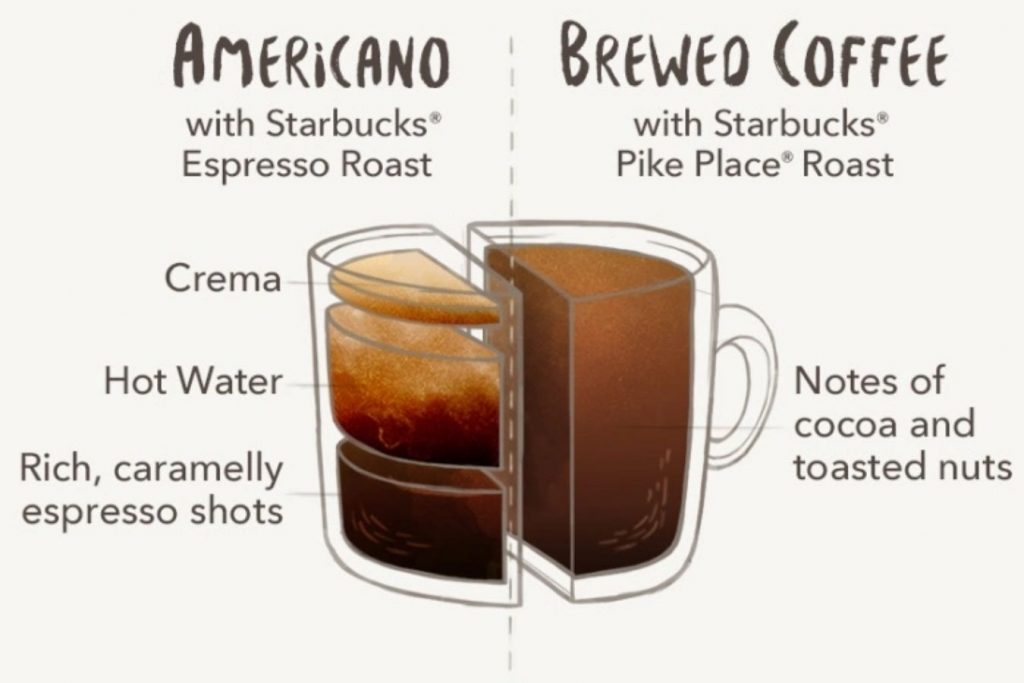
In essence, americano is made from 1 shot of espresso, for hot or cold water and ice depending on the customer’s request. In contrast, brewed coffee (called ‘coffee of the day at Starbucks) is pouredover coffee (sometimes hand dripped, but most are machine brewed with large filter paper). Americano, with its espresso-based characteristics, will still taste smoky and more bitter than brewed coffee. However, the americano is mixed with a large amount of filtered water on the outside, so the espresso is dissolved and diluted a lot resulting in the ‘body’ of the americano being quite thin. Brewed coffee is different. The whole coffee is mixed with a certain amount of hot water (1:15 or 1:18) so the ‘body’ of brewed coffee is very uniform and the flavor is stable, whether you add ice or not.
I don’t understand why americano is still selling well in many parts of the world. Maybe it is suitable for many people who want to drink a large cup of coffee but without too much caffeine and not too bitter and sour compared to ordering an espresso. Compared to brewed coffee, if you drink a cup of 300ml, your heart rate will beat faster, and your mind will be a bit tense.
Espresso and brewed coffee
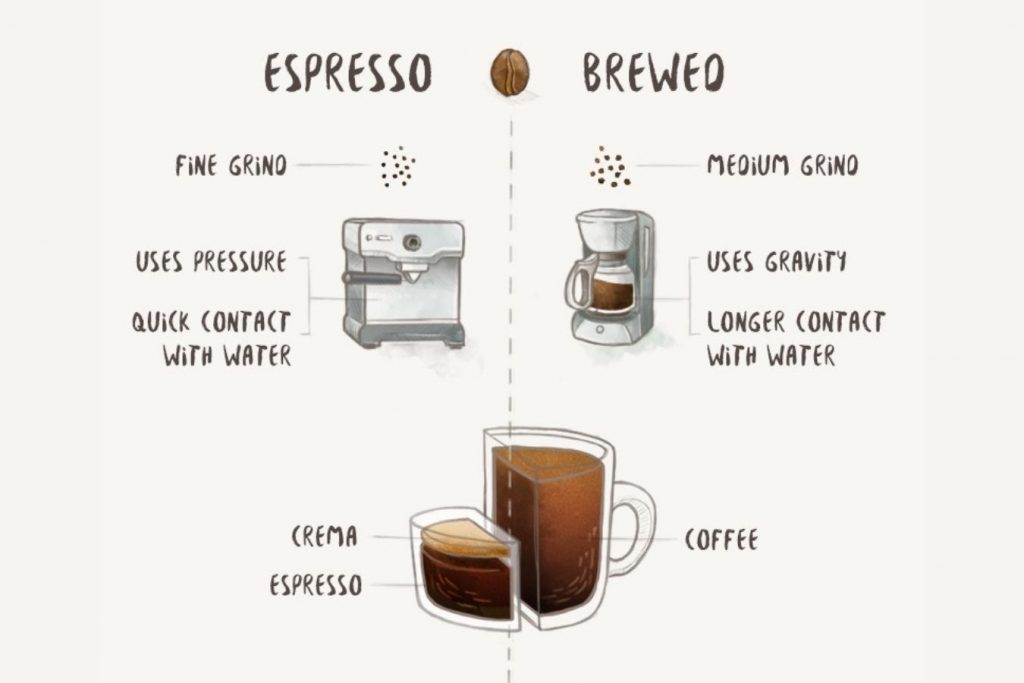
Just like the previous section, espresso and brewed are two different extraction methods, with different steam pressures, different grind levels, and different times the water meets the coffee. If the espresso uses great pressure, the beans are finely ground and the extraction time ranges from 12-15 or 20 seconds, brewed coffee brewing time can last from 03 to 04 minutes. With the extraction method of espresso machines like today, an espresso will be quite sour and have a strong taste compared to the average person, who doesn’t drink espresso, and the reaction is usually… frowning.
Brewed coffee is different and easier to drink, but somewhere in the Vietnamese mind, brewed coffee is still a bit diluted and espresso is a bit less and too sour, too thick so filtered coffee still has its place.
Espresso macchiato go to latte macchiato
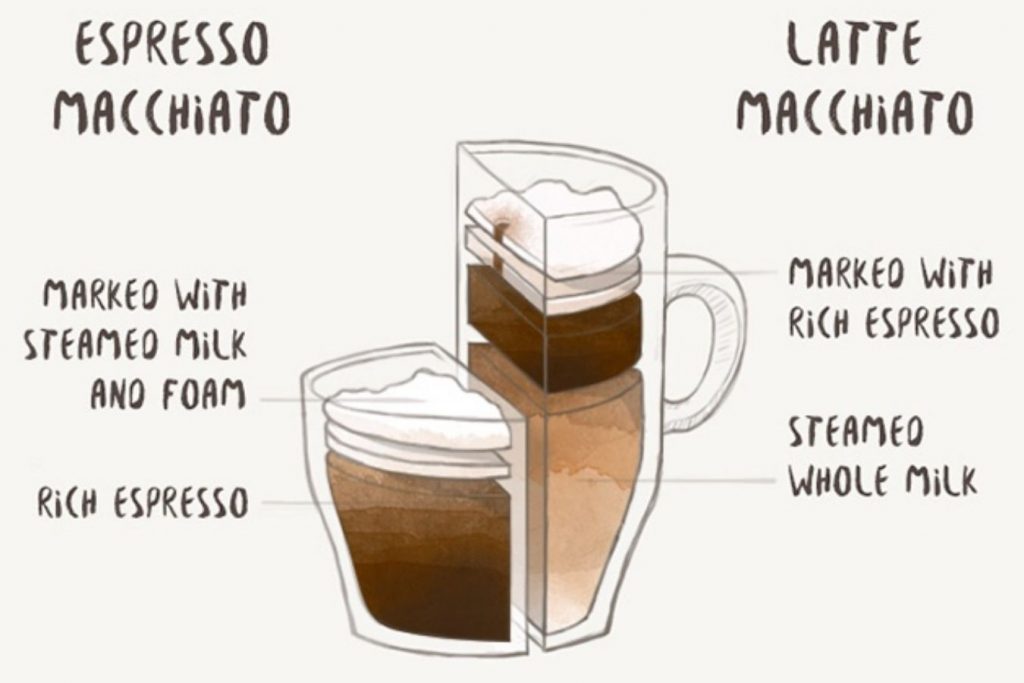
This is the most interesting part that I want to share. The first is the term ‘macchiato’, which means ‘marked’ in Italian. Italians often drink cappuccino in the morning and espresso with a little hot milk and fine foam to enhance the flavor in the afternoon. It can be understood that a macchiato or espresso macchiato is an espresso that is ‘adorned’ with a little foam milk, making it easier to drink and reducing the inherent sourness.
Latte macchiato is a bit different, with the Starbucks menu, the barista will boil the hot milk, create steamed milk first and then pour the espresso on top (the second layer) and finally the foamed milk. At this point, espresso does the job of ‘marking’ the steamed milk. Espresso used for latte macchiato will also be ‘darker’ than espresso used for a regular latte as explained by Starbucks (I don’t know how the rich espresso and espresso are extracted). Of course, if you ask yourself: If you hold two cups of latte and latte macchiato and stir them well, can you tell the difference? The answer will only be in the strength of the coffee between those two cups.
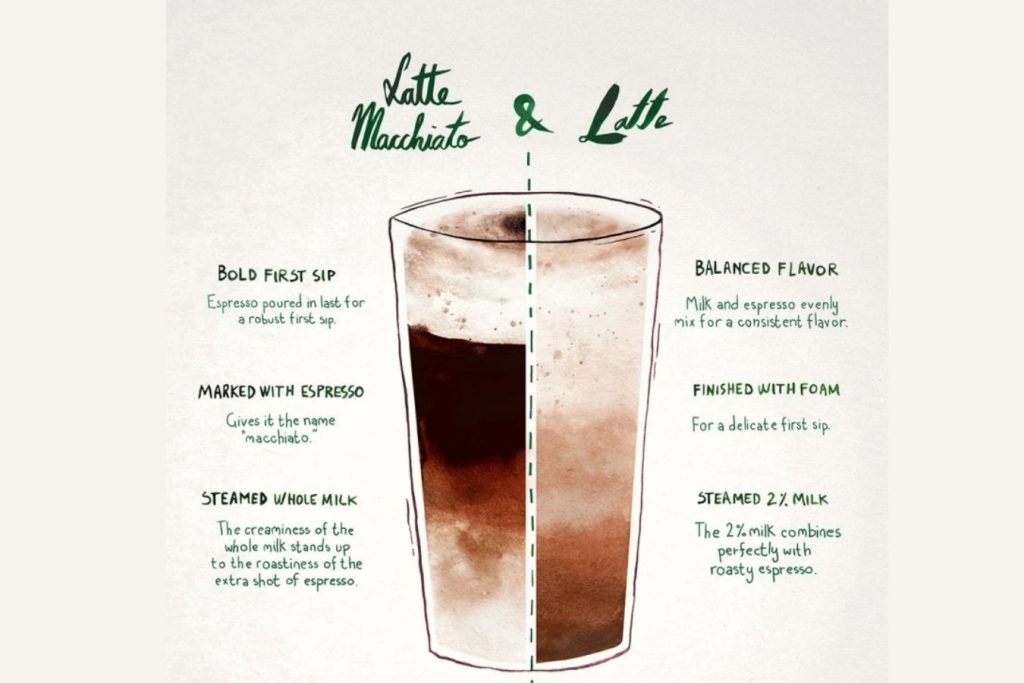
Thus, you have somewhat grasped the difference between these drinks and gradually it will be easier to choose for yourself which drink is suitable for your taste, mood, and time of day. Besides the drinks I mentioned above, there are many other ‘variants’ made from espresso that you will encounter in coffee shops everywhere you pass. For example, an espresso con pana is a shot of espresso combined with a layer of cold whipped cream, or a vanilla latte is still a latte but with a little vanilla syrup added.
On the surface, a cafe menu has quite a few drinks, but when you pay attention and understand the principles of preparation, you will see that they are all made from espresso and milk. The quality of these drinks at coffee shops depends a lot on the quality of the coffee, the quality of the milk, and the espresso machine (and the barista’s skill, too). A latte made with Dalat milk will taste better when mixed with Moc Chau milk. A high-quality arabica-based espresso is sure to taste better than the average robusta. That said, depending on the situation, the time you have as well as the purpose of drinking coffee, you can make the most reasonable decision.
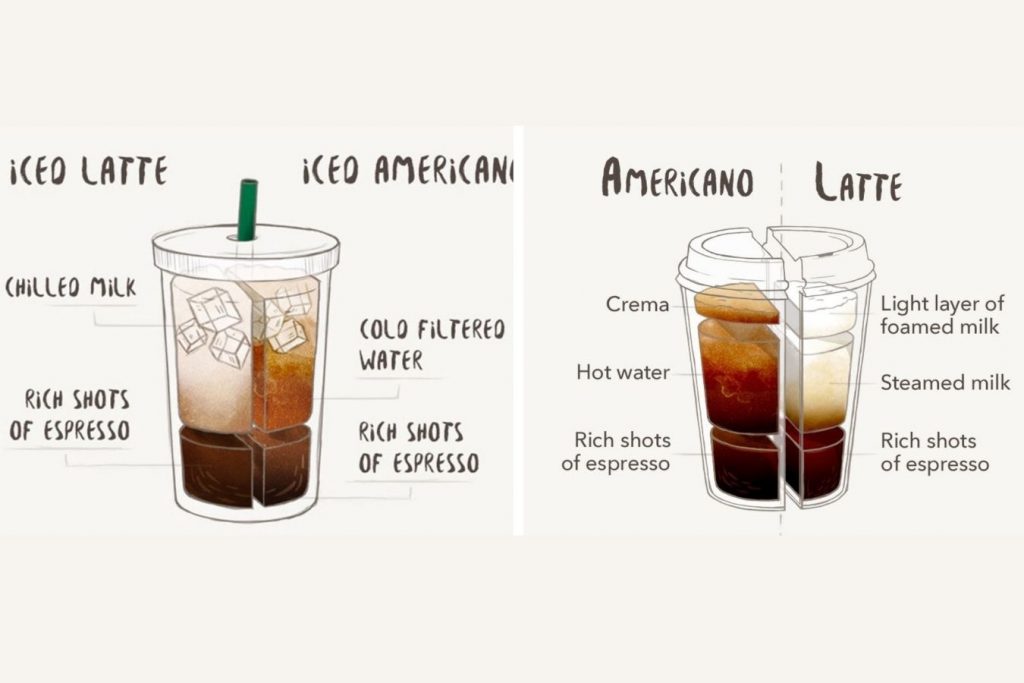
Check out some other drinks at Vietnam Coffee Starbucks
- If it’s morning and there’s no time: espresso doppio (to wake up )
- If it is morning and has time and is not sleepy: Flat white
- If it’s noon: hot brewed coffee
- If it’s the afternoon and you’ve had a lot of coffee during the day: cappuccino
- If it’s evening: ice cappuccino decaf.